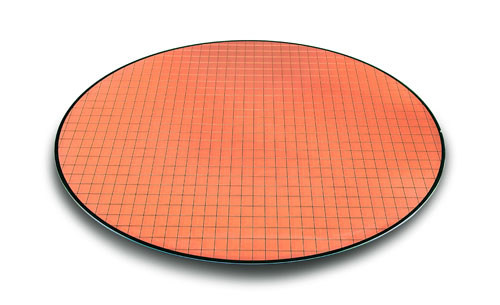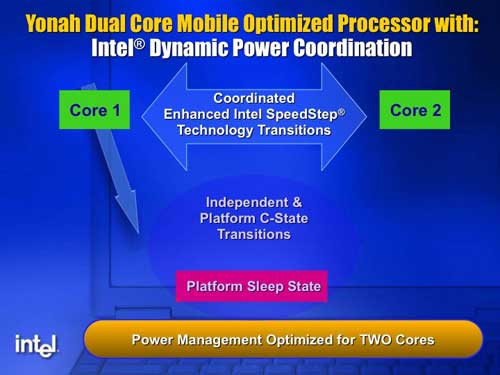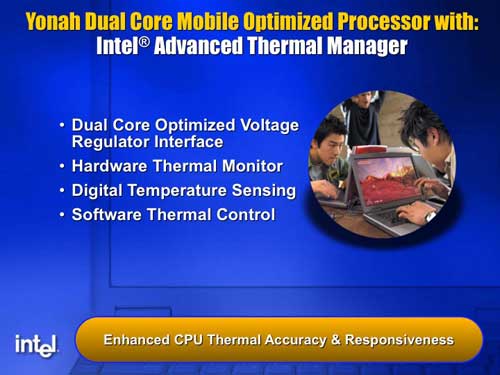Intel's Core Duo Launch - Notebook Performance Revealed
by Anand Lal Shimpi on January 5, 2006 8:00 PM EST- Posted in
- Laptops
CPU-Level Power and Thermal Enhancements
Back in March Intel's Mooly Eden told us that despite the move to two cores and almost doubling the transistor count of Dothan, Yonah notebooks would offer battery life no shorter than Dothan notebooks. In other words, you'd get all of the performance benefits of dual core but with no power consumption penalty.
While we noted that, at least on the desktop side, both the Athlon 64 X2 and Pentium D provided us with dual core performance but with only an additional 15% increase in power consumption. So it wasn't too far fetched to believe that, with enough effort, you could move to dual core, increase performance and not increase power consumption.
At the same briefing where they told us that they would keep power consumption the same, Intel also told us how they'd do it:
From the first time we heard the name Yonah we knew that its designers would be introducing some interesting power management technologies. While we don't normally like filling articles with quotes, here's one from Mooly today that is a great segue into this section:
"Yonah battery life will not be shorter than Dothan battery life...[it's] a huge achievement"
Given that Yonah will have twice the decode/execution transistors of Dothan, offering equal battery life for Yonah notebooks is a pretty impressive claim.
Mooly went through some of the power management technologies in Yonah that Intel is calling Dynamic Power Coordination. The idea is this - there are some areas where you can have each core operate independently with regards to reducing power consumption, but other areas where you can't.
Dothan has five operating states:
C0 - full power
C1 - auto halt (less power)
C2 - stop clock (even lower power)
C3 - sleep (lower power)
C4 - deep sleep (still lower)The CPU's goal is to complete the tasks it's given, while always striving to be in as low of a power state as possible. So for example, if a Dothan is running an application that doesn't require full performance, it can operate in one of the lighter power saving states until it is done working, then eventually drop all the way down to C4.
The lighter power saving stages just do things like reduce clock speed or gate the clocks to parts of the chip, these types of things can be done independently on each core in Yonah (e.g. one core can be in C1 while the other core is in C0). Once you get down to adjusting voltage and playing with the PLL, then the two cores can't act independently - since they are both fed the same voltage and clock signal. Here is where Intel's Dynamic Power Coordination comes into play; if one CPU wants to go to a lower power state (e.g. C3 or C4) but the other core is running at C0, it will inform Intel's DPC logic of the current situation. Intel's logic, as you would expect it to act, will wait until the core running in C0 is done working and then move both cores down to the lower power state. Synchronization like this is important and it helps keep power consumption down to a minimum.
Because of the power management that is needed for Yonah, the two cores have to always work closely together to make sure that they are aware of each other's power state desires - for this reason alone Yonah is already much more than a pair of Dothans with a shared cache.
Yonah also introduces finer grained thermal management through what they are calling the Advanced Thermal Manager. With dedicated digital thermal sensors in each core, each with a higher accuracy, the temperature data the CPU can feed the rest of the system is more accurate in Yonah than in previous generation Pentium M CPUs. Although Mooly didn't talk about it here, you can expect that the thermal management technology in Yonah will allow for one core to be slowed down independently of the other if power consumption or heat dissipation rises too much.
The one item that isn't mentioned, but is quite responsible for the excellent thermal and power characteristics of Intel's Core Duo is the 65nm manufacturing process it is built on.

A Yonah wafer
Intel's 65nm process is ramping up nicely and is extremely cool running and very low power. Combine it with the power management technologies talked about above and you can see how the move from Dothan to Yonah wouldn't negatively impact power consumption.












29 Comments
View All Comments
stmok - Saturday, January 7, 2006 - link
I admit it, I have no use for the Weener (Windows) keys. Its a pointless feature to have if you use other OSs or migrating AWAY from Windows. Its like Nvidia's chipset firewall solution...Another pointless feature for "Windows Only" users. (Which causes more trouble than its really worth).With Lenovo adopting all these "everyone else has it" features, its not the same ThinkPad anymore. They don't stand out technologically, like they used to.
Granted, the fingerprint scanner and keyboard light is interesting, but that's all there is. My old R40 ThinkPad has a keyboard light as well. So I guess the only thing is the fingerprint scanner.
As for ThinkVantage, that is useful...To some extent.
I tried to "clean restore" WinXP from the hidden partition (as Windows requires a clean installation after 2 or more years of use), and I get a crapload of errors. The Trackpoint or Touchpad seem to be no longer detected, and so on. And other error messages. I couldn't get past finishing the install. So I unhid that WinXP Partition, and formatted the sucker clean, gained 8GB back of HDD space. Which is enough for a quadriple boot...Win2k, Slackware, FreeBSD and Solaris. (And they all work fine with the Trackpoint/Touchpad).
Scarceas - Saturday, January 7, 2006 - link
I think Apple will focus their Intel support on the Yonah designs. I wouldn't be surprised to see a Mac Mini or something that was essentially a Yonah desktop.And I am quite glad that IBM/Lenovo are finally putting a Windows key on their Thinkpads!
Hope that carries over to their rack-mount KVM's, as well. Drives me nuts....
littlebitstrouds - Friday, January 6, 2006 - link
I wanna see a desktop board with this chip in it... then overclock the heck out of it. I bet that thing would scream.raskren - Friday, January 6, 2006 - link
Hmmm...Looks like an extremely competitive if not flat-out better Intel solution.
So where is Beenthere's a.k.a. CRAMITPAL's canned comment?
stateofbeasley - Sunday, January 8, 2006 - link
The fanboi is probably too demoralized to come out and troll. The numbers don't lie -- Core Duo is fast and efficient, and the Centrino Duo stuff is going to make Intel a pile of money.Beenthere tried to claim the opposite in his comments re the AnandTech preview, and he got run over like a Prescott in the way of an Athlon 64. Come to think of it, Beenthere's claims about Core Duo were about as stupid as claiming Prescott >>> Athlon 64.
uly - Friday, January 6, 2006 - link
"Intel 3945ABG Wireless solution""starting to look at platforms and solutions"
"the 3945ABG wireless solution is what is known as"
"915 chipset and 2915ABG wireless solution"
"wireless solutions have both been undergoing reductions"
"Pricing (with 945GM chipset and wireless solution)"
"it did give us a nice solution"
Another definition of 'solution' is something that is diluted or watered down. Wonder if Intel appreciates having their products looked upon from that perspective. (cred: buzzkiller dot net)
Anand, whenever you find yourself about to type 'solution' in the future, please think, do I really want to sound like I'm copying from the presskit?
Other than that, nice review.
raskren - Friday, January 6, 2006 - link
You read this hunting for the word "solution." Please, this is part of everyday speech, not a buzzword.uly - Friday, January 6, 2006 - link
It's part of everyday speech - for PR guys. It's also pretentious - the customer should decide the solution for himself.> You read this hunting for the word "solution."
No, I read it and buzzwords like solution kept popping out at me, so I used grep to do a quick wordcount. Seven times repeating mindless marketing drivel! C'mon Anand, I know you can write better than this.
sprockkets - Friday, January 6, 2006 - link
The inside meant that this computer had an Intel chip inside meaning better performance than those other people, way back in 1993, not that Intel focused on the insides of the computer.Watch it and this will actually be bad for them. All those people won't even recognize the intel they knew with the new logo. "Leap Ahead"? How original.
henroldus - Friday, January 6, 2006 - link
the only mistake in this excellent article is that they use the wrong memory with ddr2-533.the new core Duo supports DDR2-667.
I am wrong when I mean that this could be a bottleneck?
maybe the performance will raise with this memory but also the powerconsumption because of the higher frequency.